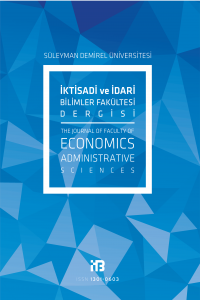SINIRLI ÖĞRENMEYİ DİKKATE ALAN FİYAT BAĞIMLI TALEPLİ DETERMİNİSTİK BİR ENVANTER MODELİ
Envanter, Ekonomik Üretim Miktarı, Fiyata Duyarlı Talep, Öğrenme
A Deterministic Inventory Model With Price-Dependent Demand Considering The Bounded Learning
-,
___
- ADLER, G.L. and R. Nanda (1974), “The effect of learning on optimal lot size determination – single product case”, AIIE Transactions, 6, s.14- 20.
- ARGOTE, L. and D. Epple (1990), “Learning curves in manufacturing”, Science, 247, s.920-924.
- AXSATER, S. and S.E. Elmaghraby (1981), “A note on EMQ under learning and forgetting”, AIIE Transactions, 13, s.86-90.
- CHENG, T.C.E. (1991), “An EOQ model with learning effect on setups”, Production Inventory Management, 32, s.83-84.
- CHENG, T.C.E. (1994), “An economic manufacturing quantity model with learning effects”, Int. Journal of Production Economics, 33, s.257- 264.
- FISK, J. and R. Ballou (1982), “Production lot sizing under a learning effect”, IIE Transactions, 14, s.257-264.
- DE JONG, J.R. (1957), “The effects of increasing skill on cycle time and its consequences for time standards”, Ergonomics, 2, s.153-166.
- JABER, M.Y. and M. Bonney (1996), “ Production breaks and the learning curve: the forgetting phenomenon”, Applied Mathematical Modelling Journal, 20, s.162-169.
- JABER, M.Y., and M.K. Salameh (1995), “Optimal lot sizing under learning considerations: shortages allowed and backordered”, Applied Mathematical Modelling, 19 (5), s.307-310.
- KEACHIE, E.C. and R.J. Fontana (1966), “Effects of learning on optimal lot size”, Management Science, 13, s.102-108.
- LI, C.L. and T.C.E. Cheng (1994), “An economic production quantity model with learning and forgetting considerations”, Production and Operations Management, 3 (2), s.118-132.
- MUTH, E.J. and K. Spremann, (1983), “Learning effect in economic lot sizing”, Management Science, 29 B102-B108.
- SMUNT, T.L. and T.E. Morton (1985), “The effects of learning on optimal lot sizes: further developments of the single product case”, IIE Transactions, 7, s.33-37.
- RACHAMADUGU, R. and C.L. Tan (1997), “Policies for lot sizing with setup learning”, International Journal of Production Economics, 48, s.157-165.
- REPLOGLE, S.H. (1988), “The strategic use of smaller lot sizes through a new EOQ model”, Production Inventory Management, 29, s.41-44.
- SALAMEH, M.K. M.U. Abdul-Malak and M.Y. Jaber (1993), “Mathematical modelling of the effect of human learning in the finite production inventory model”, Applied Mathematical Modelling Journal, 17, s.613-615.
- SULE, D.R. (1979), “The effect of alternate periods of learning and forgetting on economic manufacturing quantity”, AIIE Transactions, 10, s.338-343.
- WORTHAM, AW, and A.M. Mayyasi (1972), “Learning considerations with economic order quantity”, AIIE Transactions, 4 (1), s.69-71.
- WRIGHT, T.P. “Factors affecting the cost of airplanes”, Journal of Aeronautical Science, 3 (1936), s.122-128.
- ZHOU, Y.W. and H.S. Lau (1998), “Optimal production lot-sizing model considering the bounded learning case and shortages backordered”, Journal of the Operational Research Society, 49, s.1206
- ISSN: 1301-0603
- Yayın Aralığı: Yılda 3 Sayı
- Başlangıç: 1996
- Yayıncı: Süleyman Demirel Üniversitesi
Assist. Prof.Dr.Hüseyin ALTAY, Assist.Prof.Dr.Fatih ÇELEBİOĞLU
MALİYET HACİM KAR ANALİZİNİN BİR HASTANE İŞLETMESİ MR ÜNİTESİNDE UYGULANMASI
Yrd.Doç.Dr.M.Mustafa KISAKÜREK, Öğr.Gör.Enis Baha BİÇER
Yrd.Doç.DrHamza Bahadır ESER, Arş.Gör.Dilek MEMİŞOĞLU, Yrd.Doç.Dr.Gökhan ÖZDAMAR
EN İYİ TEDARİK ZİNCİRİ UYGULAMALARI VE BİR SAHA ÇALIŞMASI
Yrd.Doç.Dr.Mustafa Cahit UNGAN
REEL DÜNYADA SANAL AÇMAZ: SİBER ALANDA ULUSLARARASI İLİŞKİLER
Yrd.Doç.Dr.Muharrem GÜRKAYNAK, Adem Ali İREN
Ahmet KURT, Doç.Dr.Sıtkı ÇORBACIOĞLU
SINIRLI ÖĞRENMEYİ DİKKATE ALAN FİYAT BAĞIMLI TALEPLİ DETERMİNİSTİK BİR ENVANTER MODELİ
Prof.Dr.Abdullah EROĞLU, Doç.Dr.Murat KARAÖZ
TÜRKİYE’DE KRİZLER VE KRİZLERİN TURİZM SEKTÖRÜNE ETKİLERİ
